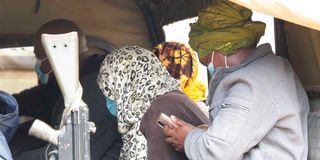FGM being carried out in grazing fields, lobby says

Seven people facing charges of subjecting six minors to FGM board a police vehicle at the Mukurweini Law courts on April 12, 2022. A lobby group now says the vice is secretly being conducted in grazing fields on the Kenya-Uganda border.
What you need to know:
- A lobby says FGM is secretly being conducted in grazing fields on the Kenya-Uganda border.
- World Vision Kenya says many children aged between 10 and 15 years are being circumcised.
- The group has also has identified hotspots where the practice is rampant.
Female genital mutilation (FGM) is secretly being conducted in grazing fields on the Kenya-Uganda border, a lobby has revealed.
The group has also has identified hotspots where the practice is rampant.
Among the areas where cases have been reported are Kasitot, Kamnai, Karagum, Lorukum, Lochorchori, Mbolongole, Kalapata, Nasal, Nauyapong and Lokiterangan villages in Alale ward, which borders Uganda, and Amudat, Nakonyen, Omanman in Uganda.
The areas are hard to reach due to lack of a reliable transport network, making it hard to fight the vice.
World Vision Kenya Alale Anti-FGM Project Officer David Krop said many children aged between 10 and 15 years are being circumcised. He spoke during a cross border anti-FGM network at North Pokot Sub-county headquarters in Alale.
“There has been a surge in FGM and early forced marriage cases. As they graze cattle, they also cut their girls and there is no one saying this. We have started the Alale Anti-FGM project early this year after residents raised the issue,” he said.
He explained that the vices happen during harvest season, starting from October through to November and during the December holidays.
“Many girls run to Uganda for the cut. They have changed the game plan, they do it secretly without community members knowing,” he said.
FGM focal person
Mr Krop added that they have established a strong surveillance team that will guide how the cases are reported and handled.
Moses Loroki, an FGM focal person from Moroto in Uganda, said cases have been rampant over the last five years.
“Many girls from Amudat, Moroto and Sebei region cross to some areas in Kenya for the cut. In 2019, we created a cross-border forum to deal with the matter. Our Kenyan counterparts rescued six girls from Loroo after they were cut in Nasal,” he said, adding that they will make sure that the anti-FGM laws are followed.
“Let’s coordinate to end FGM. Kenya is supposed to end FGM by 2022 and Uganda by 2030. We want to strengthen the aspect of surveillance and we are soon going to train the surveillance team, including the police, para-social workers, chiefs and councillors in Moroto in December. We need to have dialogue together and target boys and girls and the parent’s. Some parents blame girls for escaping and going for the knife,” he said.
Stephan Atupa, the local council woman rep for Tapat Sub-county in Moroto said that FGM issues require collaboration.
“God created us in his own image and cutting off some parts of our body is abuse against a girl child or woman. All the parts play an important role in the human body,” she said.
She noted that in October, 40 girls, 39 from Kenya, were cut in Nakonyen area in Moroto. They were from the Tepes, Karamojong and Pokot communities.
“The cutters were from Uganda and one was arrested and sentenced to four years in prison. The Matheniko community has also adapted the culture and started cutting girls yet they were not doing it,” she explained.
Kalapata Location Chief Julius Kaliamoi said that many girls have been circumcised in the area.
“We shall reach remote places and arrest the perpetrators,” he said.





